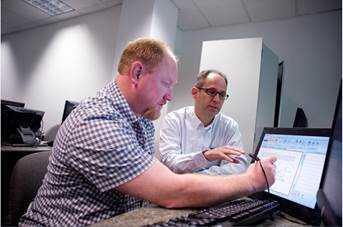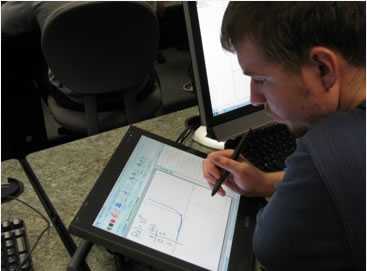Developing “collaboratories” in mathematics thanks to multi-tooled LMS’.
 Today’s colleges and universities are quickly turning to alternative pathways to traditional teaching and learning approaches, especially for core courses such as developmental mathematics and algebra—and collaboration enabled through modern Learning Management System (LMS) functionality may be one way to accomplish this rejuvenation.
Today’s colleges and universities are quickly turning to alternative pathways to traditional teaching and learning approaches, especially for core courses such as developmental mathematics and algebra—and collaboration enabled through modern Learning Management System (LMS) functionality may be one way to accomplish this rejuvenation.
Leveraging today’s key methods and technologies can create collaborative spaces that enhance student learning and outcomes. A teacher can recapture time spent on traditional lecture and create opportunities for exploration of concepts that lead to increased student engagement and mastery level learning—all while accommodating individual student learning pace variations and asynchronous learning.
The technology to help accomplish this form of pedagogy can be brought together in what is being called the “Collaboratory Approach” or simply “Collaboratory.” The term collaboratory is credited to William Wulf for interacting and sharing via software as early as 1989 (Wulf, 1993).
Today, the software is a web-based application commonly known as an LMS. With an appropriate LMS, video delivery, conferencing integration, and white board integration with digital inking capabilities, a teacher can collaborate with colleagues and students through the broadcast of synchronous instruction and learning activities online and in-class. The teacher can facilitate collaborative, shareable, personalized note-taking spaces, as well as track student engagement across multiple sections—class and student level insights that assist the teacher much like intentional formative assessment.

At the end of the course, the same data collection can be used in the creation of student portfolios of learning outcomes, which are ideal for course and program improvement, as well as, accreditation.
(Next page: Knowing the goals of a “collaboratory” via an LMS)
The goals of an LMS-enabled collaboratory, specifically for developmental mathematics and college algebra include:
The ability for online learning
Every student can “come to the board” without ever leaving their seat (or coming to campus).
Which means a STEM-proficient online assessment system
Online assessment is a primary driver in the design of this collaboratory approach, given the high effect size of improvement for effortful practice with testing (Brown, Roediger, & McDaniel, 2014; Hattie & Yates, 2014).
For STEM courses like mathematics that come with a significant reliance of symbolic characters, a system that can accept and assess such information provides valuable fidelity to the discipline, time savings, and a greater volume of student engagement.
WebAssign is a great online assessment system, because it affords the highest symbolic and mathematical fidelity needed for student engagement beyond the standard assessment (e.g., types like multiple choice and true/false). It also comes with high-fidelity symbolic capabilities from Maple, Mathematica, and MATLAB—along with embedding capabilities that enable integration of a variety of publisher’s e-content (e.g., Cengage). This e-content can incorporate technical simulations, e-book materials, and student learning support tools like “Watch it” videos; all applications pertinent to learning mathematics, physics, chemistry, and engineering.
The WebAssign online assessment system also serves as the hub of activity through which students engage and collaborate on items like homework, in class activities, quizzes, exams, video lectures, simulations, and problem-solving.
The ability to write and share
Second to the assessment system in the collaboratory LMS approach is a need to write by students and teacher using digital ink, given the benefits known (Mueller & Oppenheimer, 2014). OneNote, DyKnow, or PencilPad can be used to connect teacher and students’ digital writings with others during engagement activities where symbolic mathematical representations are crucial for increasing the mathematical fidelity of their conceptual understanding.

Problem-solving can be shared in real-time, whether a student is present in-class or attending online, through the use of digital ink. Each student is “coming to the board” to contribute and share their approach in problem solving. This conveyance of digital notes from the teacher and students’ collaboration is shared and saved for all in real-time.
Being able to couple tools like PencilPad and DyKnow on an LMS, a teacher can also ascertain the cognitive fidelity of the student’s work via a recording of the digital inking activity. For example, whether sequences are correct from start to finish or filled with intermittent “false starts” or “tangential efforts,” the writing, erasing, and writing is all there for the teacher to evaluate.
In WebAssign, data collection on a student’s digital writings now includes assessment and insights at the question-, assignment-, and class-level with both quantitative and qualitative data types. Educators can see how much a student writes as a measure of engagement (Kamin, Capitanu, Twidale, & Peiper, 2008), as well as taking what a student digitally writes and analyze it for correctness via computer algorithms (Hatfield, 2010). Two such promising tools are FluidMath, and MyScript.
(Next page: Flipping and high stakes)
A means to flip
Flipped delivery of lectures is often used in the collaboratory approach. To ensure student engagement, as well as provide the teacher with formative assessment data, the flipped delivery of lectures is embedded in WebAssign using such online tools as YouTube or EdPuzzle.
This monitoring and assessing of student lecture viewing provides key mid-level data to reduce misconceptions and develop greater conceptual understanding–leading to greater gains in disciplines like mathematics. Given the time savings from flipped delivery of lectures, a teacher can collect and analyze student writing with digital assessment capabilities or good ol’ fashion “by hand.”
Pooling capability for high stakes
Since class time is spent on concept development and building procedural fluency from these concepts, the LMS should help the teacher build questions (to occur in initial assignments, through exams, and culminating on a final exam) around material learned. From this, mastery of the content by a student (or whole class) can be tracked and displayed in the collaboratory.
As for high-stakes assessments such as module or chapter exams, these are offered in a campus testing center under proctored conditions. Exams can be taken multiple times in this format to further promote mastery learning. Given the randomization and pooling capabilities of a modern LMS, students get a greater range of questions tied to concepts, which can significantly reduce the possibility of academic misconduct.
Michael Lafreniere is an associate professor at Ohio University, Chillicothe Campus.
References
Brown, P. C., Roediger, H. L., III, & McDaniel, M. A. (2014). Make it stick: The science of successful learning. Cambridge, MA: The Belknap Press of Harvard University Press.
Hatfield, J. J. (2010). A method for automating the analysis of tablet PC ink-based student work collected using dyknow vision. In R. H. Reed & D. A. Berque (Eds.), The impact of tablet PCs and pen-based technology on education: Going mainstream (pp. 57–64). West Lafayette, Ind.: Purdue University Press.
Hattie, J., & Yates, G. (2014). Visible learning and the science of how we learn. New York: Routledge.
Kamin, S. N., Capitanu, B., Twidale, M., & Peiper, C. (2008). A “teacher’s dashboard” for a high school algebra class. In R. H. Reed, D. A. Berque, & J. C. Prey (Eds.), The impact of tablet PCs and pen-based technology on education: Evidence and outcomes (pp. 63–71). West Lafayette, IN: Purdue University Press.
Mueller, P. A., & Oppenheimer, D. M. (2014). The pen is mightier than the keyboard advantages of longhand over laptop note taking. Psychological Science, 0956797614524581. http://doi.org/10.1177/0956797614524581
Wulf, W. A. (1993). The collaboratory opportunity. Science, 261(5123), 854–855.
- 25 education trends for 2018 - January 1, 2018
- IT #1: 6 essential technologies on the higher ed horizon - December 27, 2017
- #3: 3 big ways today’s college students are different from just a decade ago - December 27, 2017

